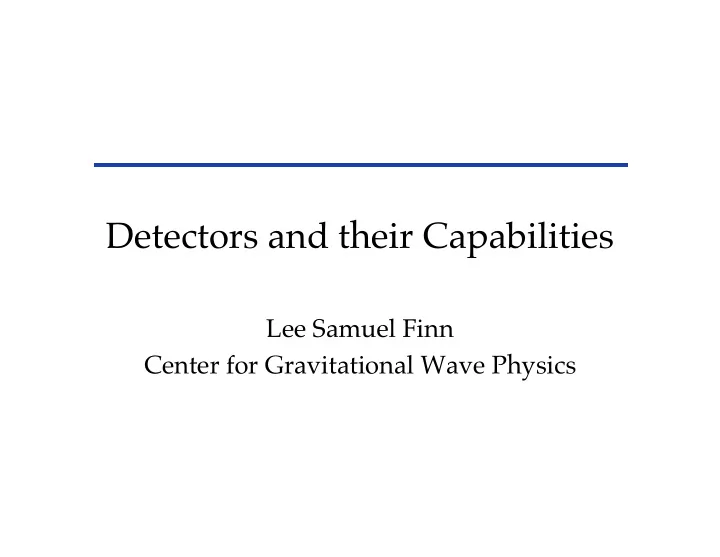

Detectors and their Capabilities Lee Samuel Finn Center for Gravitational Wave Physics
Goals & Outline • Goal: Introduction to gravitational wave detectors through the prism of stellar population science – Sources & observables, selection effects • Outline – Stellar populations and gravitational waves – Sources and observable source properties – Some sensitivity estimates
Stellar Populations and Gravitational Waves • “Source”? Stellar populations – Not necessarily an object! • Relevant gravitational wave signals? – Gravitational waves: coherent motion of mass • Mostly time-varying quadrupole – Obvious: isolated binaries (bh, ns, wd) – Less obvious: pulsars, rapidly rotating neutron stars, supernovae, GRBs (hypernovae, collapsars, AIC, binaries, etc.), nascent neutron stars, confusion-limit stochastic background, etc.
Observable Source Properties: Isolated Stars • GRBs – Possibly distinguish between binary, collapse models – Need advanced detectors, multi-spectrum observations, luck • Supernovae and other collapse events • Pulsars/rapidly rotating NS: non-axisymmetry, precession – Non-axisymmetry: ε I/r, orientation; period, sky position – Precession: ε , I/r; period, sky position • Accreting neutron stars – Secular and dynamical instabilities in, e.g., LMXBs • All signals likely weak … – Low snr in context of prospective detectors
Observable Source Properties: Isolated Binaries • Ground-based detectors (LIGO, Virgo, ?) – Populations: NS/NS, solar mass BH binaries – “Chirp mass” M = µ 3/5 M 2/5 determined with high precision – Component masses, spins, eccentricity information present but (much) less accurately determined – Sky position from time-of-arrival measurements in several detectors – Luminosity distance if localized in sky
Observable Source Properties: Isolated Binaries • LISA – Populations: • Massive BH/BH binaries: (1+ z ) M > 10 3 M � • Solar mass BH/NS capture on 10 4 –10 7 M � BH • WD/WD, WD/NS, WD/ M � BH, NS/NS, NS/BH – Orientation, sky position, eccentricity – Late inspiral captures on massive BHs, massive BH binaries: Chirp mass, eccentricity, luminosity distance – Merger of massive BHs, massive BH binaries: final mass, angular momentum – All signals strong: S/N ~ 100 or greater
Observable Source Properties: Confusion Limited Binaries • Confusion limited? – Superposition of unresolved galactic binaries • Number in orbital frequency interval ~ 1/yr large – Isolated binaries f > f 0 , confusion limited f < f 0 – Orbital f 0 ~ 10 -3 Hz given estimated number binaries – S/N ~ 60 in confusion limited regime • Transition frequency (resolved to confused), confusion limit amplitude – Related to number, space distribution, binary & binary component mass function • Distribution on sky – Amplitude, frequency, phase modulation owing to detector orbit about sun
Relevant Detectors and Basic Properties • Relevant Detectors – Ground-based detectors: GEO, LIGO, Virgo – Space-based detector: LISA • Spectrum – LIGO • 1st gen.: 40 Hz - 4 KHz • 2nd gen.: 10 Hz - 4 KHz – Virgo – LISA: 10 -3 Hz - 10 -1 Hz • Note Gap : 10 -1 Hz - 10 Hz – LISA arms too long, ground-base detectors limited by gravity-gradient noise
Relevant Detectors and Basic Properties • Source localization – Ground-based array • Aperture synthesis for coherent signals • Arrival time analysis for burst signals • Antenna pattern modulates cw signal as Earth rotates – LISA • Moving antenna pattern modulates signal as detector orbits sun • Also frequency, phase modulation • Map population distribution by antenna pattern modulation Antenna pattern for single IFO
Sensitivity Estimates: Binary Inspiral • Science Reach: Survey volume – Distance r such that observed rate of a uniformly distributed population is 4 π r 3 n /3 inspiral • Parameters – M = (1+ z ) µ 3/5 M 2/5 • Reduced mass µ , total mass M, redshift z – Target false rate • < 10 –4 /y corresponds to S/N ~ 8 – Three LIGO IFOs coalescence – r init = 21 Mpc ( M /1.2M � ) 5/6 – r adv = 300 Mpc ( M /1.2M � ) 5/6 – r ~ M 5/6 for M<10M � ringdown
Periodic Signals • Focus on pulsars • Observational constraints – f gw = 2 f pulsar – ε < ~10 –8 for old (recycled – h ∝ ε = ( ∆ I/I) ms) pulsars • Reach: upper limit on ε – 1 yr observation – 10 Kpc distance – Declination average – Significance: 95% • Theoretical prejudice – ε < ~ 10 –6 • From pure Coulumb lattice crust strength
γ -ray bursts Hypernovae; Black hole + • γ -ray burst triggered by collapsars; NS/NS, debris torus formation of ~M � bh NS/BH, He/BH, WD/BH mergers; – Expect grav.-wave burst AIC; … • Individual grav.-wave bursts not detectable γ -rays generated by – Distance, amplitude, etc., internal or external conspire against shocks Relativistic • Look for statistical fireball 2 1/ 2 association: − 22 ( ) 1.35 × 10 LIGO I T 1000 2 < h 95% 2 = h Det 2 2.5 × 10 − 23 ( ) 0.2s N on LIGO II – Adv. LIGO bound equiv to ~0.3M � in grav.-waves at z = 1/2
Comments • Ground-based detectors operate in regime of rare, weak, isolated sources – Except, perhaps, for ~ 10M � /10M � BH binaries • LISA detectors operate in regime of many strong sources – Galactic binary sources unresolved in large part of band with snr ~ 60 • “In principle” is not yet “in practice” – Analysis immature: much of what we know we can do in principle we don’t yet know how to do in practice – Especially true for LISA • LISA science goals (and, thus, capabilities) still under definition
Recommend
More recommend